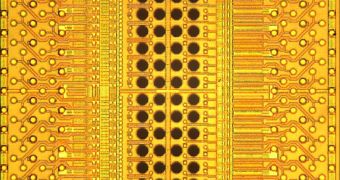Processors that use light to transfer data, instead of electrical signals, are something that the IT industry has been working on for a long time, but IBM seems to be doing the best in this area.
The company has shown that it succeeded in its effort to make an optical chipset that can move information eight times faster than today's parallel optical components.
“Holey Optochip”, as the prototype is called, can transfer one trillion bits per second, which is the same as one terabit.
That is the equivalent of the bandwidth used by 100,000 people linked to 10 Mbps high-speed networks.
To give some perspective, the Holey Optochip can transfer the whole US Library of Congress web archive somewhere else in an hour or so.
“Reaching the one trillion bit per second mark with the Holey Optochip marks IBM’s latest milestone to develop chip-scale transceivers that can handle the volume of traffic in the era of big data,” said IBM researcher Clint Schow, a member of the team that built the prototype.
“We have been actively pursuing higher levels of integration, power efficiency and performance for all the optical components through packaging and circuit innovations. We aim to improve on the technology for commercialization in the next decade with the collaboration of manufacturing partners.”
IBM's Holey Optochip is a standard silicon CMOS chip with 48 holes in it, through which 24 receiver and 24 transmitter channels accept and send information.
The company even managed to build it with components that are already commercially available, which means that mass production should be an easy thing to set up.
Additionally, the chip is even energy-efficient, needing much less power than a common light bulb (the power needed by one 100W bulb is enough for 20 transceivers).
All in all, IBM expects future systems, especially big data and cloud installations, to extensively utilize optical chips.

 14 DAY TRIAL //
14 DAY TRIAL //